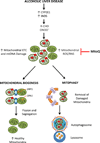Convergent mechanisms for dysregulation of mitochondrial quality control in metabolic disease: implications for mitochondrial therapeutics
- PMID: 23356271
- PMCID: PMC3582193
- DOI: 10.1042/BST20120231
Convergent mechanisms for dysregulation of mitochondrial quality control in metabolic disease: implications for mitochondrial therapeutics
Abstract
Mitochondrial dysfunction is associated with a broad range of pathologies including diabetes, ethanol toxicity, metabolic syndrome and cardiac failure. It is now becoming clear that maintaining mitochondrial quality through a balance between biogenesis, reserve capacity and mitophagy is critical in determining the response to metabolic or xenobiotic stress. In diseases associated with metabolic stress, such as Type II diabetes and non-alcoholic and alcoholic steatosis, the mitochondria are subjected to multiple 'hits' such as hypoxia and oxidative and nitrative stress, which can overwhelm the mitochondrial quality control pathways. In addition, the underlying mitochondrial genetics that evolved to accommodate high-energy demand, low-calorie supply environments may now be maladapted to modern lifestyles (low-energy demand, high-calorie environments). The pro-oxidant and pro-inflammatory environment of a sedentary western lifestyle has been associated with modified redox cell signalling pathways such as steatosis, hypoxic signalling, inflammation and fibrosis. These data suggest that loss of mitochondrial quality control is intimately associated with the aberrant activation of redox cell signalling pathways under pathological conditions. In the present short review, we discuss evidence from alcoholic liver disease supporting this concept, the insights obtained from experimental models and the application of bioenergetic-based therapeutics in the context of maintaining mitochondrial quality.
Figures

Similar articles
-
Targetable Pathways for Alleviating Mitochondrial Dysfunction in Neurodegeneration of Metabolic and Non-Metabolic Diseases.Int J Mol Sci. 2021 Oct 23;22(21):11444. doi: 10.3390/ijms222111444. Int J Mol Sci. 2021. PMID: 34768878 Free PMC article. Review.
-
Mitochondrial biogenesis: pharmacological approaches.Curr Pharm Des. 2014;20(35):5507-9. doi: 10.2174/138161282035140911142118. Curr Pharm Des. 2014. PMID: 24606795
-
Mitochondrial dysfunction and oxidative stress in metabolic disorders - A step towards mitochondria based therapeutic strategies.Biochim Biophys Acta Mol Basis Dis. 2017 May;1863(5):1066-1077. doi: 10.1016/j.bbadis.2016.11.010. Epub 2016 Nov 9. Biochim Biophys Acta Mol Basis Dis. 2017. PMID: 27836629 Free PMC article. Review.
-
Mitochondrial stress: a bridge between mitochondrial dysfunction and metabolic diseases?Cell Signal. 2011 Oct;23(10):1528-33. doi: 10.1016/j.cellsig.2011.05.008. Epub 2011 May 15. Cell Signal. 2011. PMID: 21616143 Free PMC article. Review.
-
Mitochondrial dynamics, mitophagy and cardiovascular disease.J Physiol. 2016 Feb 1;594(3):509-25. doi: 10.1113/JP271301. Epub 2016 Jan 15. J Physiol. 2016. PMID: 26537557 Free PMC article. Review.
Cited by
-
Assessing Cardiac Metabolism: A Scientific Statement From the American Heart Association.Circ Res. 2016 May 13;118(10):1659-701. doi: 10.1161/RES.0000000000000097. Epub 2016 Mar 24. Circ Res. 2016. PMID: 27012580 Free PMC article. Review.
-
Regulators of mitochondrial quality control differ in subcutaneous fat of metabolically healthy and unhealthy obese monkeys.Obesity (Silver Spring). 2017 Apr;25(4):689-696. doi: 10.1002/oby.21762. Epub 2017 Feb 25. Obesity (Silver Spring). 2017. PMID: 28236433 Free PMC article.
-
Metabolic Syndrome and β-Oxidation of Long-Chain Fatty Acids in the Brain, Heart, and Kidney Mitochondria.Int J Mol Sci. 2022 Apr 6;23(7):4047. doi: 10.3390/ijms23074047. Int J Mol Sci. 2022. PMID: 35409406 Free PMC article. Review.
-
Inhibition of autophagy and glycolysis by nitric oxide during hypoxia-reoxygenation impairs cellular bioenergetics and promotes cell death in primary neurons.Free Radic Biol Med. 2013 Dec;65:1215-1228. doi: 10.1016/j.freeradbiomed.2013.09.006. Epub 2013 Sep 19. Free Radic Biol Med. 2013. PMID: 24056030 Free PMC article.
-
Role of mitochondrial quality control in the pathogenesis of nonalcoholic fatty liver disease.Aging (Albany NY). 2020 Mar 26;12(7):6467-6485. doi: 10.18632/aging.102972. Epub 2020 Mar 26. Aging (Albany NY). 2020. PMID: 32213662 Free PMC article. Review.
References
-
- Altamirano J, Bataller R. Alcoholic liver disease: pathogenesis and new targets for therapy. Nat Rev Gastroenterol Hepatol. 2011;8:491–501. - PubMed
-
- Seth D, Haber PS, Syn WK, Diehl AM, Day CP. Pathogenesis of alcohol-induced liver disease: classical concepts and recent advances. Journal of gastroenterology and hepatology. 2011;26:1089–1105. - PubMed
-
- Corrao G, Ferrari P, Zambon A, Torchio P, Arico S, Decarli A. Trends of liver cirrhosis mortality in Europe, 1970–1989: age-period-cohort analysis and changing alcohol consumption. Int. J. Epidemiol. 1997;26:100–109. - PubMed
-
- Day CP. Genes or environment to determine alcoholic liver disease and nonalcoholic fatty liver disease. Liver Int. 2006;26:1021–1028. - PubMed
Publication types
MeSH terms
Grants and funding
- AA015172/AA/NIAAA NIH HHS/United States
- HL 103859/HL/NHLBI NIH HHS/United States
- R01 AA015172/AA/NIAAA NIH HHS/United States
- R21 DK073775/DK/NIDDK NIH HHS/United States
- R01 AA013395/AA/NIAAA NIH HHS/United States
- HL 94518/HL/NHLBI NIH HHS/United States
- DK073775/DK/NIDDK NIH HHS/United States
- R01 HL103859/HL/NHLBI NIH HHS/United States
- R01 HL094518/HL/NHLBI NIH HHS/United States
- P30 DK079626/DK/NIDDK NIH HHS/United States
- R01 NS064090/NS/NINDS NIH HHS/United States
- NS064090/NS/NINDS NIH HHS/United States
- AA018841/AA/NIAAA NIH HHS/United States
- R01 AA018841/AA/NIAAA NIH HHS/United States
- AA13395/AA/NIAAA NIH HHS/United States
- T32 DK007545/DK/NIDDK NIH HHS/United States
LinkOut - more resources
Full Text Sources
Other Literature Sources
Medical

